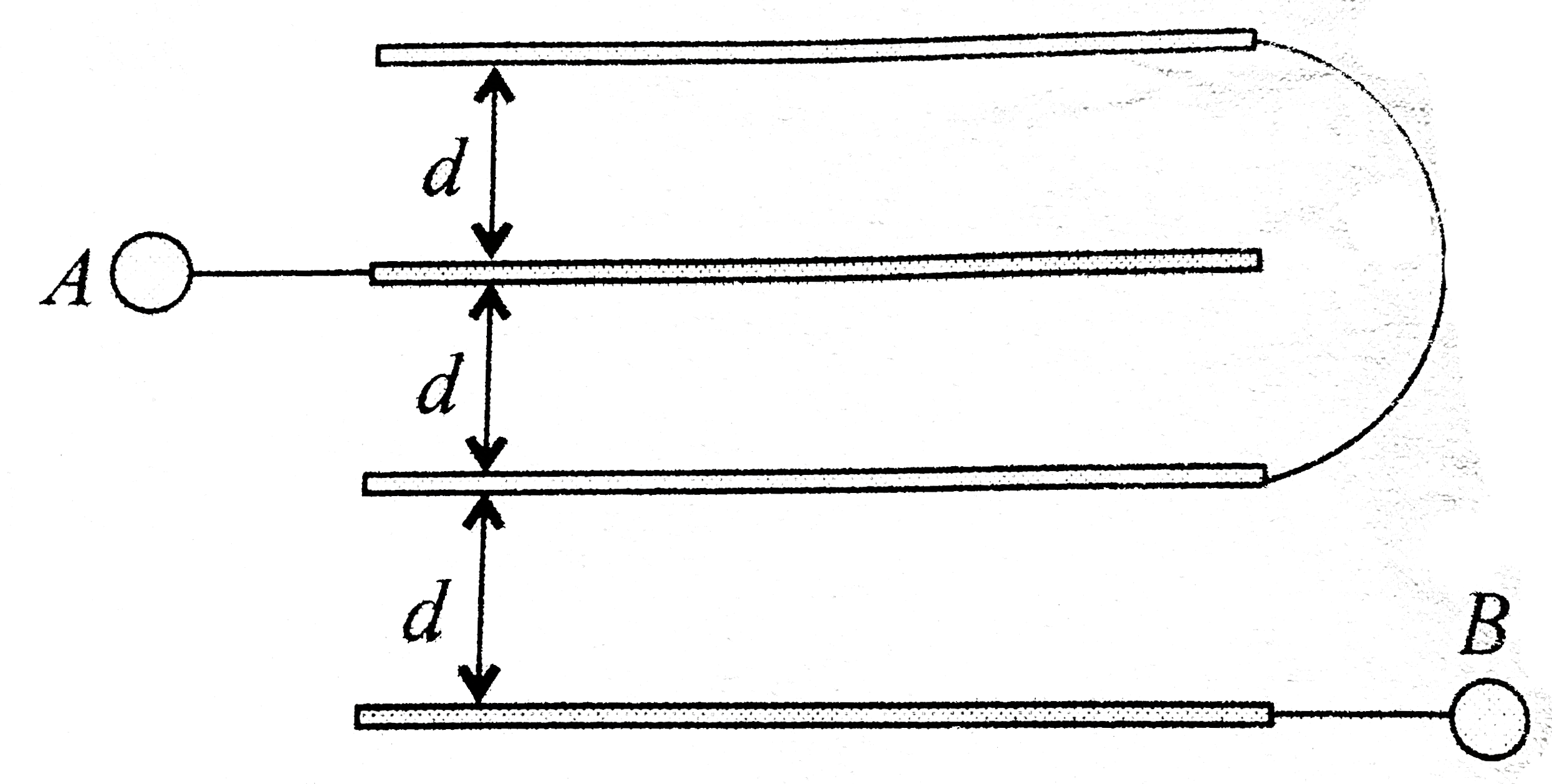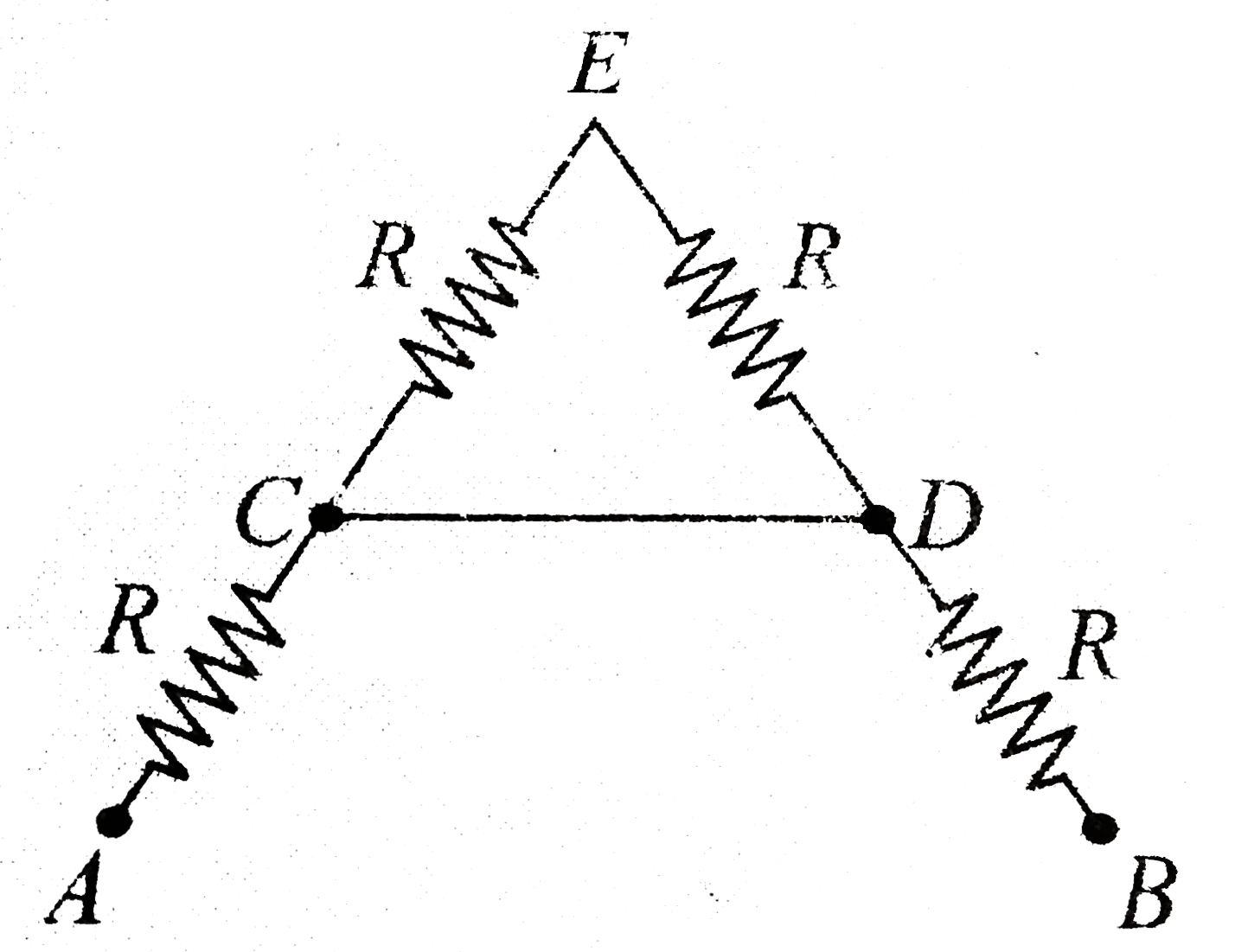Four identical plates, each having area A, are arranged as shown in Fig. Find the equicalent capacity of the structure between (A) and (B).
 .
.
Method 1 : Let the potentials of plates A and B be VA and VB respectively. As the plates (1) and (2) are comected together, they will have a common potential, say (V'). Now we will make an equivalent circuit digram by connecting the different plates across the assumed potential defference.

The equivalent capcitance between A and B can easily be calculated as follows:
Ceq=23C=23ε0Ad
Method 2: Let us assume that battery is connected between A and B Let potentials of A and B be V and 0. plates (1) and (2) are connceted together and both have the same potential (V'). The charge supplied by the positive terminal og the battery to plate (1) be (Q), same charge will come out from plate (4). The outermost surface of the plates will carry no charge . Hence, −Q charge will appear on the inner surface of plate (4). The charge distribution on different surfaces of the paltes can be done by using conservation of charge. The charge appearing on the facing surfaces should be equal and opposite. The equal and opposite. The charges appearing on difference surfaces are shown in. The capacitance of the system of plates can be given by
C=QV−0 (i)
Between plates (i) and (2),
(Q−x)=C(V−V') (ii)
Between plates (2) and (3),
x=C(V−V') (iii)
Between plates (3) and (4).
Q=C(V'−0) (iv)
From (ii) and (iii),(iv)
(Q−x)=x or x=Q2 (v)
Adding Eqs. (iii) and (iv), we get (v)
V=xC+QC=3Q2C or QC=23C=232ε0Ad=Ceq.
Topper's Solved these Questions
- CAPACITOR AND CAPACITANCEBOOK - CENGAGE PHYSICS ENGLISHCHAPTER - CAPACITOR AND CAPACITANCEEXERCISE - Solved Examples
10 Videos
- CAPACITOR AND CAPACITANCEBOOK - CENGAGE PHYSICS ENGLISHCHAPTER - CAPACITOR AND CAPACITANCEEXERCISE - Exercise 4.1
13 Videos
- ATOMIC PHYSICSBOOK - CENGAGE PHYSICS ENGLISHCHAPTER - ATOMIC PHYSICSEXERCISE - ddp.4.3
15 Videos
- CENGAGE PHYSICS DPPBOOK - CENGAGE PHYSICS ENGLISHCHAPTER - CENGAGE PHYSICS DPPEXERCISE - subjective type
51 Videos
Similar Questions
Five identical plates, each having area A are arranged as shown in Fig. Find the equivalennt capacity of the strusture between A and B?
 .
.
View SolutionFour identical resistances each having value R are arranged as shown in Figure. Find the equivalent resistance between A and B.

View SolutionDifferent capacitors are arranged as shown in Fig. 4.42 Final the equivalent capacity across the points (A) and (B).
 .
.
View SolutionFind the equicalent capacitance between points AandB as show in
 .
.
View SolutionSix identical capacitors of each capacitance .C. are arranged as shown in fig .The equivalent capacitance between A and B is KC8 . The value of .K. is ..........

View SolutionIf each capacity C, find the capacitance between A and B

View SolutionIn the arrangement shown , find the equivalent capacitance between A and B

View SolutionFind the equivalent resistance between A and B.

View SolutionSeven identical plates each of area A and successive separation d are arranged as shown in figures, the effective capacitance of the system between

View SolutionFour identical metal plates are placed in air parallel to each other with distances d from one another. The area of each plate is equal to A. The arrangement is shown in the figure. Find the capacitance of the system between plates P and R.

View Solution
